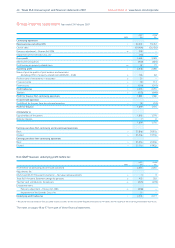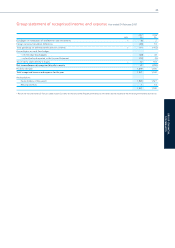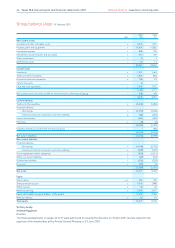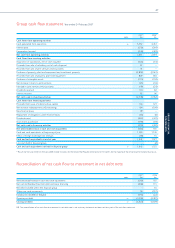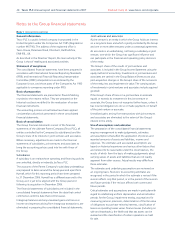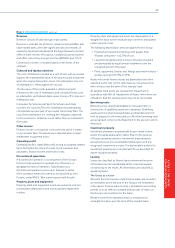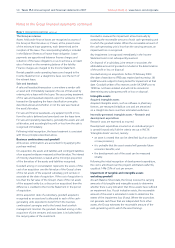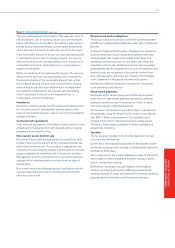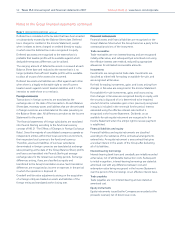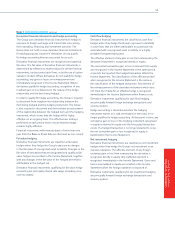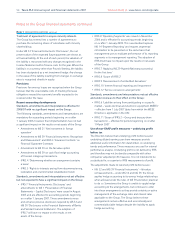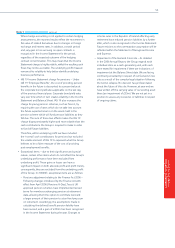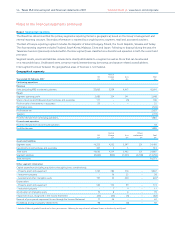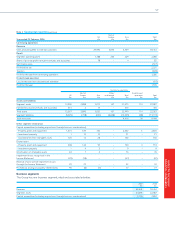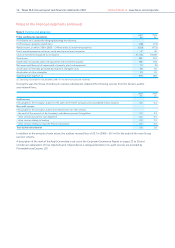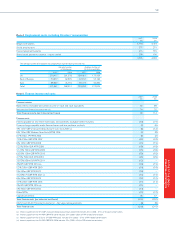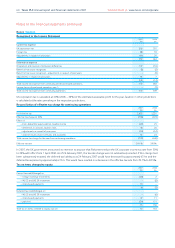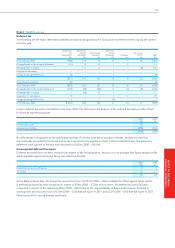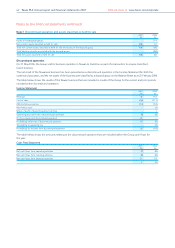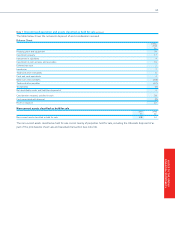Tesco 2007 Annual Report Download - page 56
Download and view the complete annual report
Please find page 56 of the 2007 Tesco annual report below. You can navigate through the pages in the report by either clicking on the pages listed below, or by using the keyword search tool below to find specific information within the annual report.
Notes to the Group financial statements continued
Note 1 Accounting policies continued
54 Tesco PLC Annual report and financial statements 2007 Find out more at www.tesco.com/corporate
Treatment of agreements to acquire minority interests
The Group has entered into a number of agreements to
purchase the remaining shares of subsidiaries with minority
shareholdings.
Under IAS 32 ‘Financial Instruments: Disclosures’, the net
present value of the expected future payments are shown as
a financial liability. At the end of each period, the valuation of
the liability is reassessed with any changes recognised in the
Income Statement within finance costs for the year. Where the
liability is in a currency other than Pounds Sterling, the liability
has been designated as a net investment hedge. Any change
in the value of the liability resulting from changes in exchange
rates is recognised directly in equity.
Provisions
Provisions for onerous leases are recognised when the Group
believes that the unavoidable costs of meeting the lease
obligations exceed the economic benefits expected to be
received under the lease.
Recent accounting developments
Standards, amendments and interpretations effective for
2006/07 with no significant impact on the Group:
The following standards, amendments and interpretations are
mandatory for accounting periods beginning on or after
1 January 2006, however, their implementation has not had
a significant impact on the results or net assets of the Group:
• Amendment to IAS 21 ‘Net investment in foreign
operation’
• Amendment to IAS 39 ‘Financial Instruments: Recognition
and Measurement’ and IFRS 4 ‘Insurance Contracts’ on
Financial Guarantee Contracts
• Amendment to IAS 39 on the fair value option
• Amendment to IAS 39 on cash flow hedge accounting
of forecast intragroup transactions
• IFRIC 4 ‘Determining whether an arrangement contains
a lease’
• IFRIC 5 ‘Rights to interests arising from decommissioning,
restoration and environmental rehabilitation funds’
Standards, amendments and interpretations not yet effective
but not expected to have a significant impact on the Group:
• IFRS 7 ‘Financial Instruments: Disclosures’ and
amendments to IAS 1 ‘Presentation of Financial
Statements – Capital Disclosures’ were issued in August
2005 and are effective for accounting periods beginning
on or after 1 January 2007. These amendments revise
and enhance previous disclosures required by IAS 32 and
IAS 30 ‘Disclosures in the Financial Statements of Banks
and Similar Financial Institutions’. The adoption of
IFRS 7 will have no impact on the results or net
assets of the Group.
• IFRS 8 ‘Operating Segments’ was issued in November
2006 and is effective for accounting periods beginning
on or after 1 January 2009. This new standard replaces
IAS 14 ‘Segment Reporting’ and requires segmental
information to be presented on the same basis that
management uses to evaluate performance of its reporting
segments in its management reporting. The adoption of
IFRS 8 will have no impact upon the results or net assets
of the Group.
• IFRIC 7 ‘Applying IAS 29 ‘Hyperinflationary accounting’
for the first time’
• IFRIC 8 ‘Scope of IFRS 2’
• IFRIC 9 ‘Reassessment of embedded derivatives’
• IFRIC 10 ‘Interim financial reporting and impairment’
• IFRIC 12 ‘Service concession arrangements’
Standards, amendments and interpretations not yet effective
and under review as to their effect on the Group:
• IFRIC 6 ‘Liabilities arising from participating in a specific
market – waste electrical and electronic equipment (WEEE)’
– effective from 1 July 2007 (date from which the WEEE
Directive is applicable in the UK)
• IFRIC 11 ‘Scope of IFRS 2 – Group and treasury share
transactions’ – effective for periods beginning on or after
1 March 2007
Use of non-GAAP profit measures – underlying profit
before tax
The Directors believe that underlying profit before tax and
underlying diluted earnings per share measures provide
additional useful information for shareholders on underlying
trends and performance. These measures are used for internal
performance analysis. Underlying profit is not defined by IFRS
and therefore may not be directly comparable with other
companies’ adjusted profit measures. It is not intended to be
a substitute for, or superior to IFRS measurements of profit.
The adjustments made to reported profit before tax are:
• IAS 32 and IAS 39 ‘Financial Instruments’ – fair value
remeasurements – under IAS 32 and IAS 39, the Group
applies hedge accounting to its various hedge relationships
when allowed under the rules of IAS 39 and when practical
to do so. Sometimes the Group is unable to apply hedge
accounting to the arrangements, but continues to enter
into these arrangements as they provide certainty or active
management of the exchange rates and interest rates
applicable to the Group. The Group believes these
arrangements remain effective and economically and
commercially viable hedges despite the inability to apply
hedge accounting.


